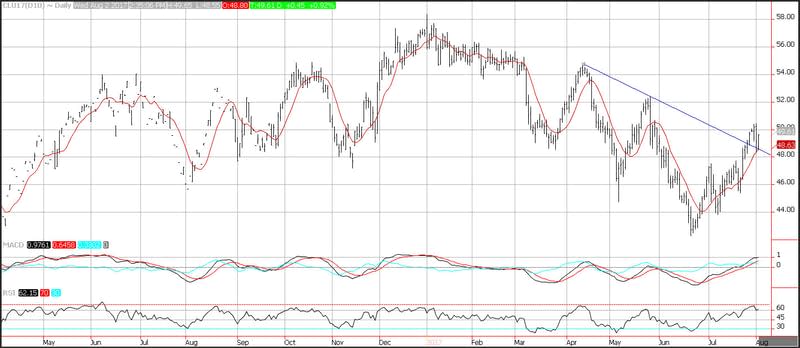Crude Oil Price Analysis for August 3, 2017
WTI crude oil prices whipsawed first moving lower down to $48 per barrel in the wake of an unexpected build in crude oil inventories reported by the API. Prices then were under pressure most of the session despite a decline in inventories from the 3-major categories. What got the crude oil market to move higher was the realization that demand was picking up as gasoline demand moved higher for the first time during the summer of 2017, posting its first year over year gain. Demand for distillates which include heating oil remains elevated rising nearly 15% year over year.
Technicals
Crude oil prices rebounded from session lows after testing support near the 10-day moving average at 48.63. Resistance on crude oil is seen near the weekly highs at 50.41. A break of this level would generate a test of target resistance near the May highs at 52.38. Momentum is neutral, as prices form a consolidation pattern. The MACD (moving average convergence divergence) index is printing in the black but the trajectory of the MACD histogram is negative, which points to consolidation. The relative strength index (RSI) which is a momentum oscillator that measures accelerating and decelerating momentum, has stalled, near the 62 level which is on the upper end of the neutral range and reflects a positive trend that is consolidation.

Imports Rebounded but the Monthly Average is Down
There was a rebound in imports in the last week of July, but expectations are that a decline in Saudi exports in August will reduce oil coming into the United States. The EIA reported that U.S. crude oil imports averaged about 8.3 million barrels per day last week, up by 209,000 barrels per day from the previous week. The monthly average of imports actually declined. The EIA stated that crude oil imports averaged about 8.0 million barrels per day, 3.8% below the same monthly period last year.
Inventories Declined Less than Expected
While inventories declined less than expected, the number was in the same direction compared to the unexpected rise in oil inventories reported on Tuesday by the American Petroleum Institute. The EIA reported that U.S. commercial crude oil inventories decreased by 1.5 million barrels from the previous week. Gasoline inventories decreased by 2.5 million barrels last week, while distillate fuel inventories decreased by 0.2 million barrels last week. Despite a decline in each of the 3-major categories, total commercial petroleum inventories increased by 1.1 million barrels last week.
Demand Remains Positive
Demand for products is moving higher. The DOE reported that total products demand over the last month averaged about 20.8 million barrels per day, up by 1.4% from the same period last year. Over the month, gasoline demand averaged about 9.8 million barrels per day, up by 0.1% from the same period last year. Distillate fuel demand continues to impress, as it averaged about 4.2 million barrels per day over the last month, up by 14.5% from the same period last year.
Refinery Runs Increased
U.S. crude oil refinery inputs averaged 17.4 million barrels per day during the week ending July 28, 2017, 123,000 barrels per day more than the previous week’s average. Refineries operated at 95.4% of their operable capacity last week. Gasoline production decreased last week, averaging 10.3 million barrels per day. Distillate fuel production increased last week, averaging over 5.2 million barrels per day.
The API Reported an Unexpected Build
The American Petroleum Institute reported a build of 1.628 million barrels compared to expectations of a draw of 3 million barrels for the week ending July 14. Offsetting the unexpected decline was a massive drawdown in gasoline inventories which fell by 5.448 million barrels for the week ending July 14, compared to analyst expectations that inventories for the fuel would fall by only 500,000 barrels.
The Dollar Moved Lower on Softer Than Expected Payrolls
U.S. ADP reported private payrolls increased 178k in July, modestly below forecast, though it follows an upwardly revised 191k gain in June. The services sector added 174k workers, with strength in professional/business services, up 65k, while education rose 43k. Trade and transport industries added 24k workers, while jobs in the leisure sector increased 15k. The goods sector added 4k workers, including a 6k gain in construction, a 3k gain in mining, while manufacturing fell 4k.
This article was originally posted on FX Empire

